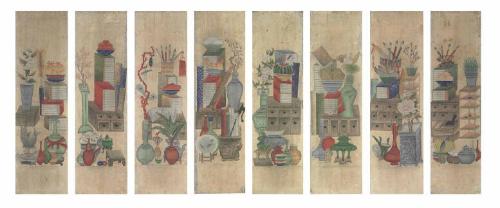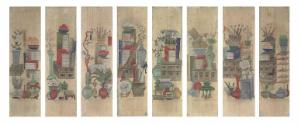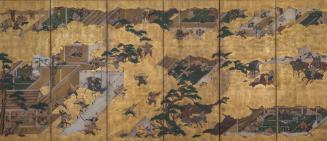Books and Scholars' Possessions
Datelate 19th or early 20th century
PeriodJoseon dynasty (1392–1897) or Korean Empire (1897–1910)
CultureKorean
MediumEight-panel folding screen; ink and color on paper
ClassificationPaintings
Credit LineMuseum purchase, 2016
Object numberSN11543
Folding screens depicting arrangements of scholarly accoutrements mixed with auspicious motifs called munbangdo ("scholar’s study painting”) flourished as a genre of painting between the 18th and early 20th centuries on the Korean peninsula. Confucianism, the dominant ethical framework of the Joseon dynasty (1392–1897), placed a high value on education; a screen such as this expressed the erudition and refined tastes of the owner, as well as wishes for a harmonious and prosperous home.
Each of the eight panels comprises an independent composition of closely stacked objects. These include tools associated with the scholar’s study such as brushes, ink, boxed sets of books, rolls of paper, and a pair of reading glasses; as well as treasures like archaic bronzes, porcelains, viewing stones, musical instruments, and a branch of red coral. We can also find symbolic items such as peacock feathers for nobility, watermelon and pomegranate for fertility, and peaches for longevity.
On View
Not on viewCollections
Overall (each inner panel): 72 × 17 1/4 × 9/16 in. (182.9 × 43.8 × 1.4 cm)
Image (Each Painting): 41 1/2 × 12 1/4 in. (105.4 × 31.1 cm)
18th century
Late 17th–early 18th century
c. 1880–1910
Late 17th–early 18th century















